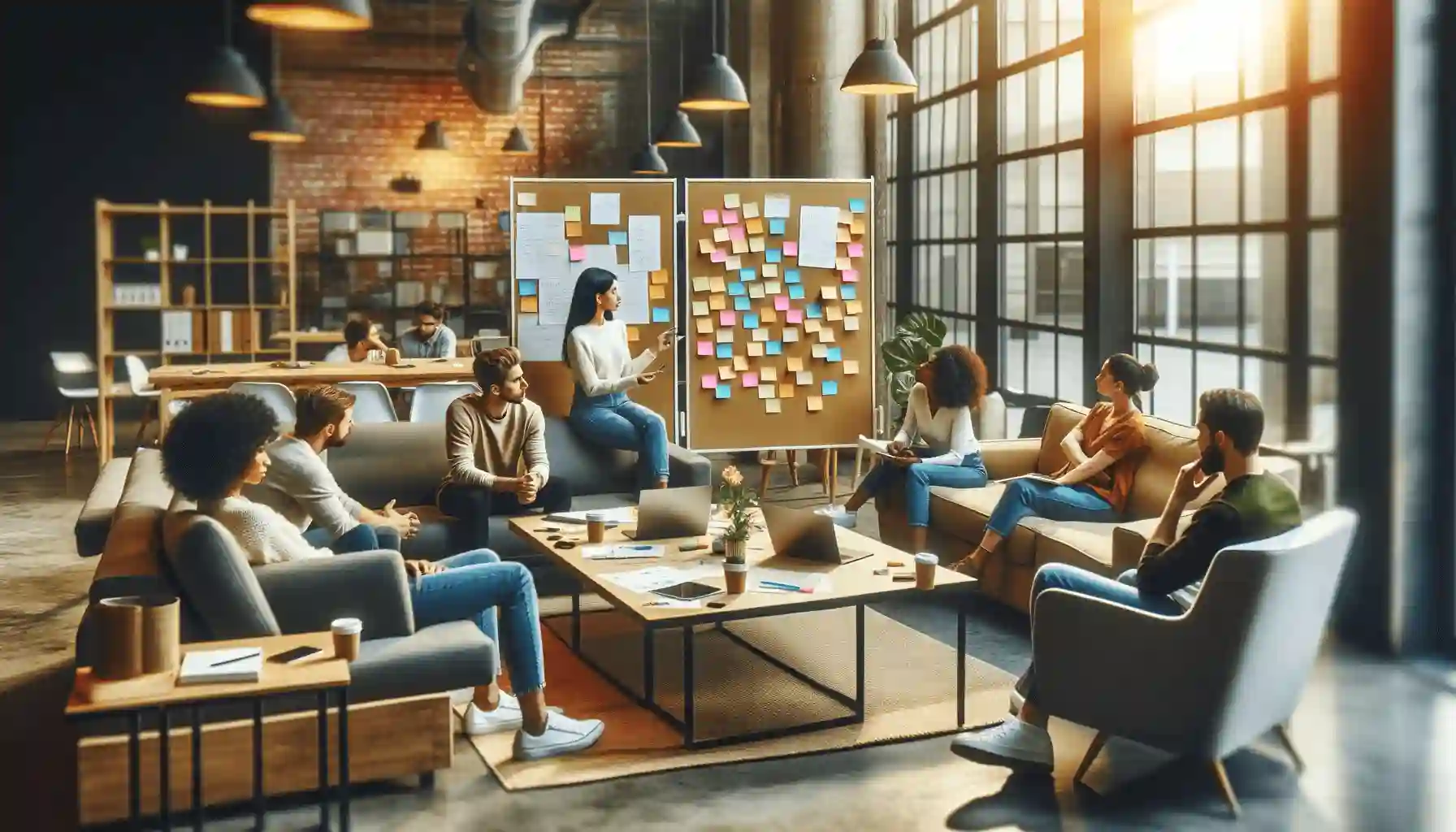Brainstorming Meeting
This guide will walk you through the essential elements of use brainstorming meeting to keep your attendees aligned and engaged.
Try Lark for Free
Brainstorming meetings are dynamic sessions designed to generate creative ideas, solve complex problems, and foster innovation within teams and organizations. These meetings harness the collective intelligence and creativity of participants to explore new concepts, develop solutions, and drive progress. In this comprehensive guide, we'll delve into the significance of brainstorming meetings, how to conduct them effectively, and best practices for maximizing creativity and idea generation.
Use Lark Meetings to turn meetings into true collaborative experiences.
What is a brainstorming meeting?
Unleashing Creativity
A brainstorming meeting is a collaborative gathering where individuals come together to generate a wide range of ideas, solutions, or suggestions on a specific topic or challenge. These meetings encourage participants to think freely, explore unconventional approaches, and build upon each other's ideas.
Goals of brainstorming meetings
Sparking Innovation
The primary goals of brainstorming meetings include:
- Idea Generation: Stimulating the creation of diverse and innovative ideas.
- Problem Solving: Finding creative solutions to challenges or issues.
- Team Engagement: Involving team members in collaborative and creative processes.
- Exploration: Encouraging exploration of new concepts and possibilities.
Who should attend brainstorming meetings?
Key Participants
Brainstorming meetings benefit from diverse perspectives and contributions. Key participants may include:
- Team Members: Individuals with direct involvement or expertise in the topic or challenge.
- Facilitator: A neutral facilitator who guides the meeting and ensures it remains focused on the agenda.
- Subject-Matter Experts: Experts or specialists who can provide insights and context.
Related:
Master the Art of Meeting Notes with Lark for Enhanced Collaboration | Lark Blog | Lark BlogLearn more about Lark x Meetings
Topics, agenda, and structure of brainstorming meetings
Structuring the Meeting
A well-structured brainstorming meeting typically follows a defined agenda and may include the following components:
- Introduction: Setting the meeting's purpose, objectives, and guidelines.
- Problem Statement: Clearly defining the challenge or topic for brainstorming.
- Idea Generation: Encouraging participants to share their ideas, thoughts, and solutions.
- Idea Sharing: Allowing participants to present and explain their ideas.
- Open Discussion: Facilitating discussions, questions, and feedback on presented ideas.
- Idea Clustering: Grouping similar ideas and identifying patterns or themes.
- Prioritization: Selecting the most promising ideas or solutions.
- Action Planning: Defining next steps, responsibilities, and timelines.
- Conclusion: Summarizing the meeting and next actions.
How to conduct an effective brainstorming meeting?
Step-by-Step Guide
Conducting an effective brainstorming meeting requires a structured approach. Follow these steps for successful brainstorming meetings:
- Preparation: Define the meeting's objective and select participants based on their relevance to the topic.
- Agenda Creation: Develop a clear and structured agenda, allocating time for each component.
- Facilitation: Appoint a skilled facilitator who can guide the meeting, encourage participation, and manage time.
- Idea Generation: Encourage participants to think freely and generate ideas individually.
- Idea Sharing: Provide each participant with an opportunity to present their ideas to the group.
- Open Discussion: Foster a positive and open atmosphere for questions, clarifications, and feedback.
- Idea Clustering: Group similar ideas and identify patterns or themes to streamline discussions.
- Prioritization: Collaboratively decide on the most promising ideas or solutions using predefined criteria.
- Action Planning: Define actionable steps, responsibilities, and timelines for implementing selected ideas.
- Documentation: Keep records of all ideas, discussions, and decisions made during the meeting.
- Follow-Up: Ensure that action items are communicated and tracked post-meeting, and provide updates as necessary.
Learn more about Lark x Meetings
How often should you hold brainstorming meetings?
Meeting Frequency
The frequency of brainstorming meetings depends on the organization's needs and the nature of the challenges or topics being addressed. Some organizations conduct regular brainstorming sessions, while others hold them as needed to tackle specific issues or pursue innovation initiatives. The key is to schedule brainstorming meetings when they align with the organization's goals and objectives.
Key differences between brainstorming meetings and similar meetings
Understanding Distinctions
Brainstorming meetings have unique characteristics that set them apart from other types of meetings:
- Creativity Focus: These meetings are specifically designed to stimulate creative thinking and idea generation.
- Open Dialogue: They encourage open and non-judgmental discussion, allowing participants to explore unconventional ideas.
- Diverse Participation: Brainstorming meetings thrive on the diverse contributions of participants from various backgrounds and perspectives.
Related:
Master the Art of Meeting Notes with Lark for Enhanced Collaboration | Lark Blog | Lark BlogLearn more about Lark x Meetings
Common pitfalls of brainstorming meetings
Avoiding Mistakes
To ensure the success of brainstorming meetings, be cautious of these common pitfalls:
- Dominant Voices: Allowing a few participants to dominate discussions while stifling others.
- Negative Criticism: Encouraging judgmental or critical comments that hinder idea generation.
- Lack of Focus: Straying from the meeting's agenda or losing sight of the objective.
- Overwhelming Ideas: Managing a large number of ideas without clear organization or prioritization.
Tips for maximizing the impact of brainstorming meetings
Enhancing Creativity
To maximize the impact of brainstorming meetings, consider implementing these tips:
- Diverse Participation: Include individuals with different backgrounds, perspectives, and expertise.
- Open-Mindedness: Encourage participants to suspend judgment and explore unconventional ideas.
- Time Management: Allocate sufficient time for idea generation and discussions without rushing.
- Idea Clustering: Group similar ideas to streamline discussions and identify common themes.
- Prioritization Criteria: Define clear criteria for evaluating and selecting the most promising ideas.
Learn more about Lark x Meetings
Examples
Real-world scenarios
Real-world scenarios
Let's explore three real-world scenarios of effective brainstorming meetings in various contexts:
Scenario 1: Product Innovation Brainstorming Meeting
Brief Content: A cross-functional team in a consumer electronics company gathers for a brainstorming meeting to generate innovative ideas for a new product line.
Detailed Content: The brainstorming meeting kicks off with an introduction to the company's goal of launching a cutting-edge product line. Each team member is provided with materials, including market research data and competitor analysis. Participants are encouraged to generate
as many creative ideas as possible within a designated time frame. The meeting fosters open dialogue, with team members sharing their concepts, regardless of how unconventional they may seem. As ideas flow, a facilitator records them on a whiteboard. The team engages in discussions, provides feedback, and explores potential synergies among ideas. Following the brainstorming session, the team collectively selects the most promising ideas using predetermined criteria, such as market potential and feasibility. The meeting concludes with an action plan to further develop and prototype the selected concepts.
Scenario 2: Problem-Solving Brainstorming Meeting
Brief Content: An IT support team conducts a brainstorming meeting to address a persistent technical issue affecting company operations.
Detailed Content: The brainstorming meeting begins with a clear problem statement: an ongoing technical issue causing system downtimes. The team, composed of IT specialists with different expertise areas, is tasked with identifying potential solutions. Participants are given time to brainstorm individually, jotting down their ideas on sticky notes. During the idea sharing phase, each team member presents their suggestions, and the facilitator organizes the ideas on a board, grouping them by common themes. The team engages in a discussion to evaluate the feasibility, cost-effectiveness, and potential impact of each proposed solution. Participants express their concerns, ask clarifying questions, and provide feedback. Through this collaborative process, the team reaches a consensus on the most viable solution. The meeting concludes with a detailed action plan outlining the steps required to implement the chosen solution, assign responsibilities, and establish timelines.
Scenario 3: Marketing Campaign Brainstorming Meeting
Brief Content: A marketing team convenes a brainstorming meeting to develop a creative and impactful marketing campaign for a new product launch.
Detailed Content: The brainstorming meeting commences with an overview of the new product, its unique features, and the target audience. Team members are encouraged to think creatively and generate ideas for the campaign's theme, messaging, and channels. Participants take turns presenting their concepts, which range from interactive social media campaigns to captivating video advertisements. As ideas are shared, the facilitator captures them on a digital board, allowing for easy rearrangement and organization. The team engages in lively discussions, sharing insights, concerns, and suggestions. After a thorough exploration of ideas, the team votes on the most compelling and feasible concepts, considering factors like budget and timeline constraints. The meeting concludes with a well-defined plan for the marketing campaign, including specific content creation tasks, promotional strategies, and launch dates.
Tips for do's and don'ts
Best Practices and Pitfalls to Avoid
Follow these do's and don'ts to ensure productive and effective brainstorming meetings:
| Do's | Don'ts |
|---|---|
| Encourage participants to think freely and express unconventional ideas. | Don't allow judgmental or critical comments that stifle creativity. |
| Foster open dialogue and active participation from all team members. | Avoid rushing through the idea generation process or limiting discussion time. |
| Allocate sufficient time for idea generation and discussions without rushing. | Don't let dominant voices overshadow others or discourage participation. |
| Define clear criteria for evaluating and selecting the most promising ideas. | Neglect to document all ideas, discussions, and decisions made during the meeting. |
| Group similar ideas to streamline discussions and identify common themes. | Don't overwhelm participants with too many ideas to manage effectively. |
Use Lark Meetings to turn meetings into true collaborative experiences.
A Game Changer for Brainstorming Meeting: Empower your team with Lark Meetings
In the fast-paced and dynamic world of modern business, effective communication and collaboration are crucial for success of Brainstorming Meeting. Here we introduce Lark Meetings to serve as a centralized hub for all communication needs.
Transform your meetings into collaborative endeavors
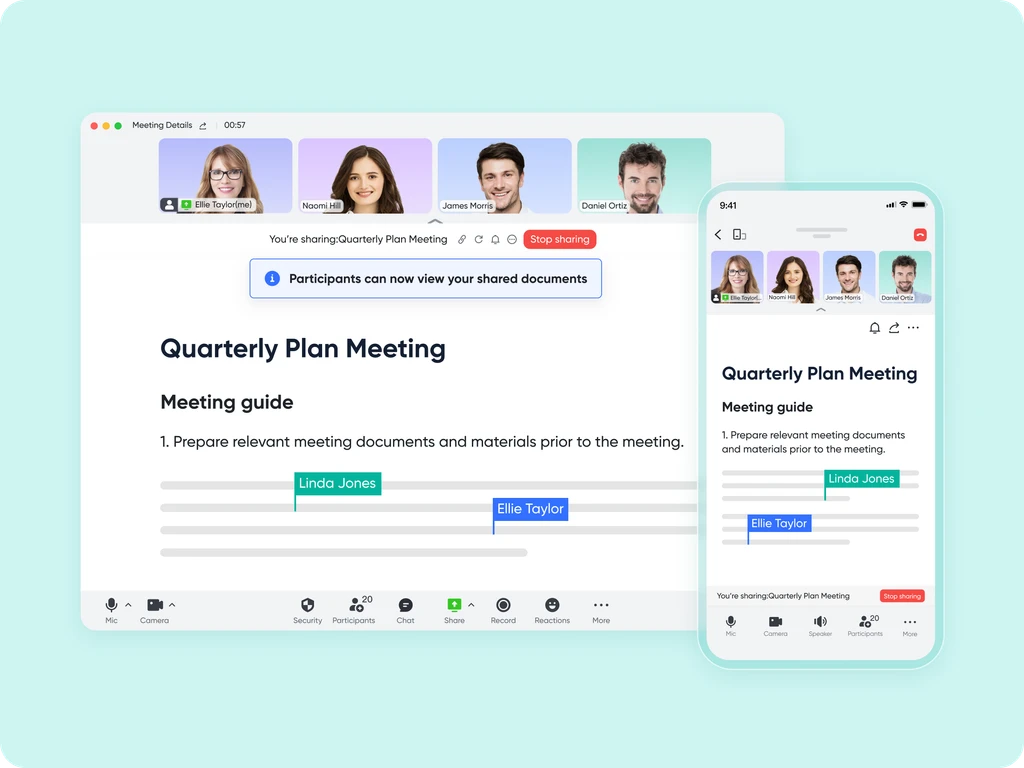
Leverage the potency of in-call document sharing, intelligent meeting minutes, and mobile-optimized features to enhance productivity collaboratively, irrespective of your location or schedule.
Seamlessly collaborate in real-time, across any device
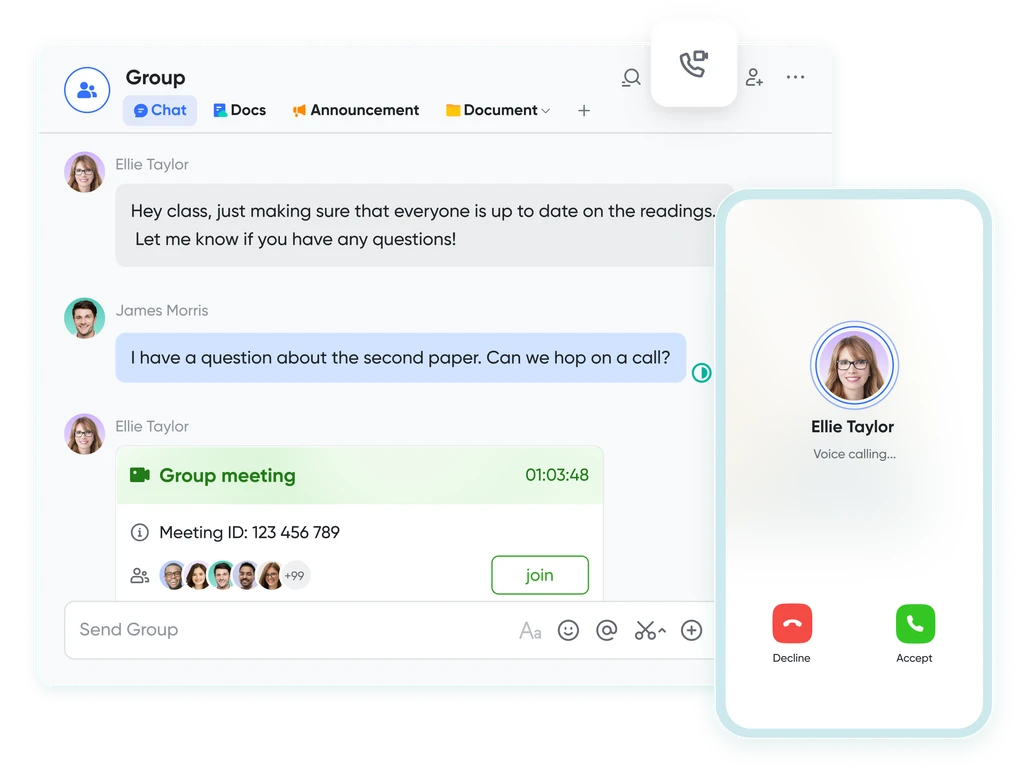
Share live documents instead of just screen views. Participants can navigate and edit simultaneously within the video call window, even while on the move.
Shift your focus to engagement, not note-taking
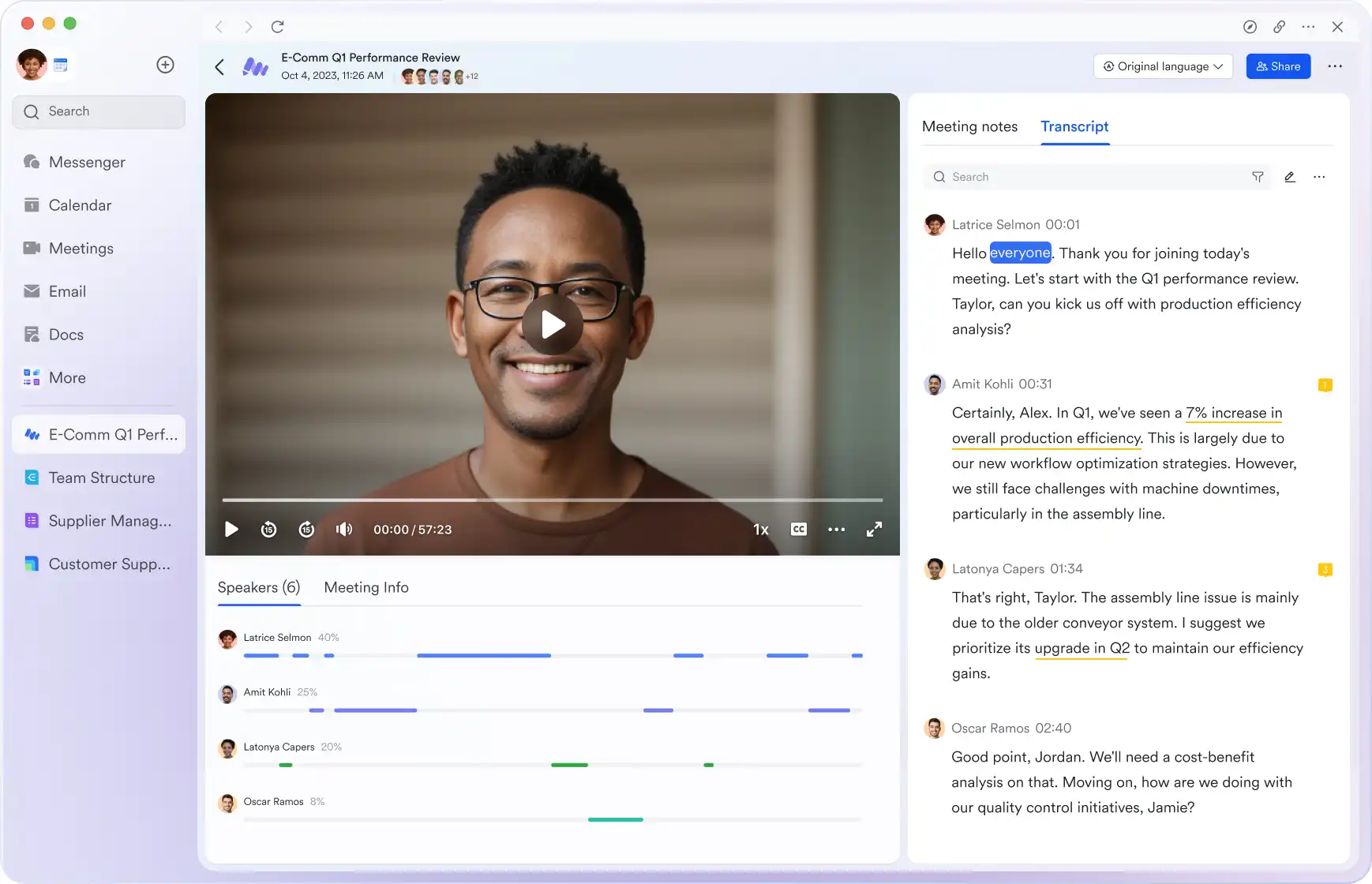
Lark Minutes automatically converts video meetings into transcripts, facilitating easy viewing, searching, and collaborative editing. Stay in the loop asynchronously, even if you can't attend the live meeting. Lark Minutes for meeting minutes support translation into 10+ different languages.
Break language barriers in communication
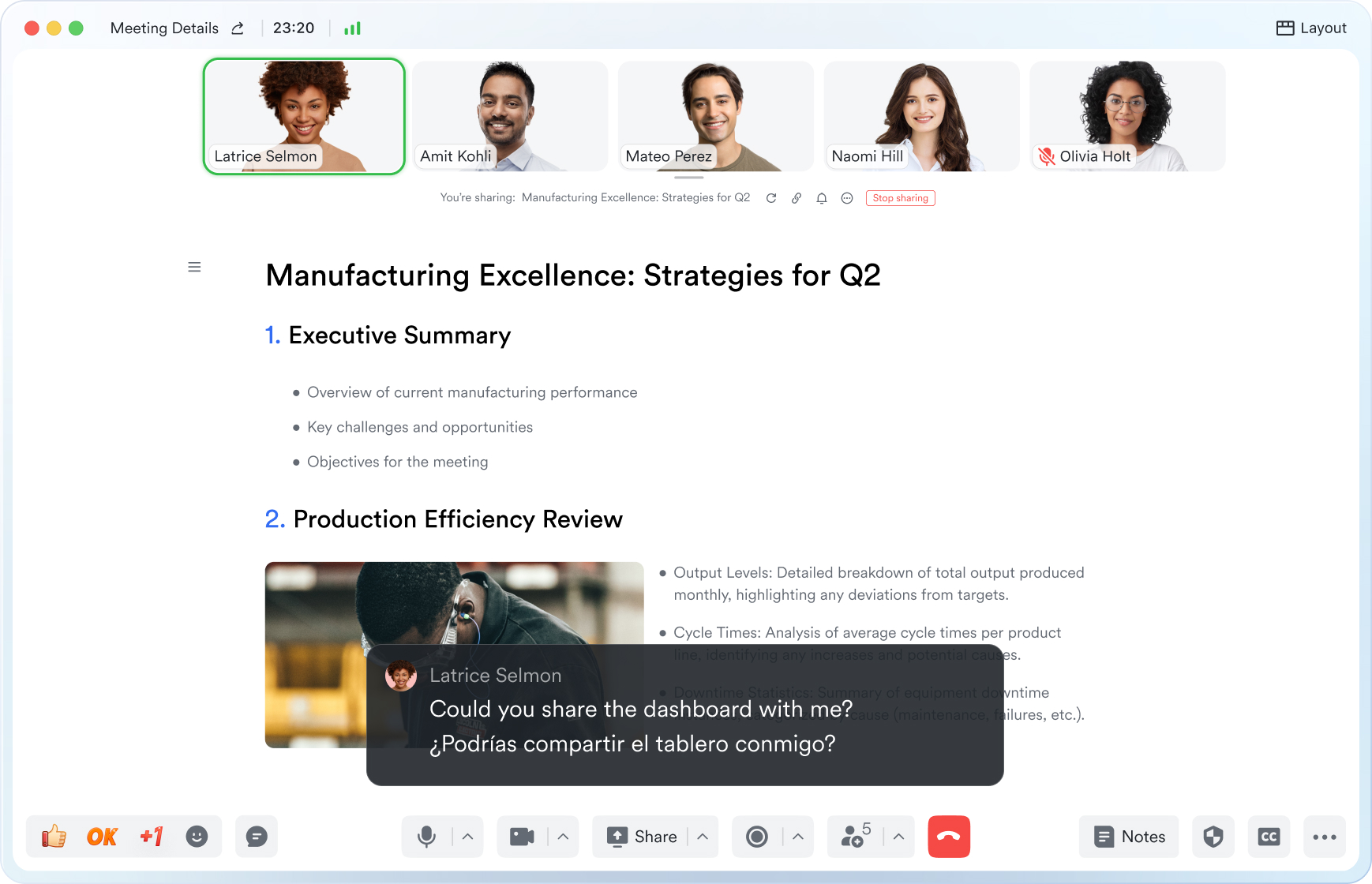
Lark Meetings provide real-time translation for subtitles, allowing individuals from diverse backgrounds to express themselves in their native languages. Ensure every voice is heard, regardless of geographical location. Live subtitles currently support translations from English, Chinese, and Japanese to 10+ different languages. See more translation feature in Lark.
Connect with larger audiences
Host dynamic online meetings and events accommodating up to 1,000 participants, with the flexibility of up to 50 breakout sessions for intimate group discussions within the larger meeting context. Try more Lark features for free.





